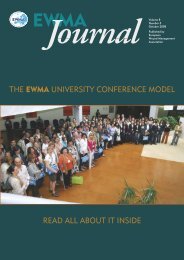best practice for the management of lymphoedema ... - EWMA
best practice for the management of lymphoedema ... - EWMA
best practice for the management of lymphoedema ... - EWMA
You also want an ePaper? Increase the reach of your titles
YUMPU automatically turns print PDFs into web optimized ePapers that Google loves.
COMPRESSION<br />
GARMENTS<br />
FIGURE 39 Circular knit machine<br />
Garments are shaped by varying<br />
yarn tension and stitch height<br />
during knitting.<br />
FIGURE 40 Flat knit handpiece<br />
be<strong>for</strong>e sewing<br />
Garments are shaped by adding<br />
and removing needles during<br />
knitting.<br />
that some manufacturers’ compression<br />
class pressure ranges <strong>for</strong> lower limb hosiery<br />
may be different from <strong>the</strong> compression class<br />
ranges used <strong>for</strong> upper limb garments. To<br />
assist comparison, <strong>the</strong>re<strong>for</strong>e, garment<br />
packaging and studies involving<br />
compression garments should state <strong>the</strong><br />
pressure ranges and <strong>the</strong> testing method<br />
used to determine <strong>the</strong> pressures.<br />
LIMB SHAPE AND GARMENT<br />
CHOICE<br />
Limb shape plays an important role in<br />
choosing compression garments. Ready to<br />
wear compression garments are suitable<br />
where <strong>the</strong>re is no or minimal limb distortion,<br />
but can be more difficult to fit precisely and,<br />
if circular knit, may roll at <strong>the</strong> top. Custom<br />
made garments can be made to<br />
accommodate a wide range <strong>of</strong> anatomical<br />
distortion. Flat knit garments do not roll,<br />
curl, twist or tourniquet, can achieve a<br />
better fit, and can be made with zippers to<br />
aid application.<br />
FITTING COMPRESSION GARMENTS<br />
C Compression<br />
garments <strong>for</strong> patients with<br />
<strong>lymphoedema</strong> should be fitted by<br />
appropriately trained practitioners.<br />
Prescription <strong>of</strong> compression garments<br />
should only be undertaken after full<br />
assessment <strong>of</strong> <strong>the</strong> patient, and should take<br />
into account factors such as <strong>the</strong> stage and<br />
severity <strong>of</strong> <strong>the</strong> <strong>lymphoedema</strong>, <strong>the</strong> patient's<br />
BOX 31 Tips <strong>for</strong> compression garment measurement<br />
com<strong>for</strong>t, preferences, lifestyle,<br />
psychosocial status, concurrent disease,<br />
and ability to apply and remove garments.<br />
Patients with skin problems such as<br />
dermatitis or psoriasis and those with<br />
known allergies to substances like elastane<br />
benefit from <strong>the</strong> use <strong>of</strong> cotton rich<br />
garments.<br />
Patients should be measured <strong>for</strong><br />
garments when swelling has been<br />
minimised, pitting oedema is absent or<br />
minimal, any shape distortion optimised<br />
and <strong>the</strong> area stabilised (Box 31).<br />
Accurate measurement is important to<br />
achieve correct fit <strong>of</strong> ready to wear and<br />
custom made garments. Measurements<br />
required will usually include<br />
circumferential measurements at several<br />
given sites and longitudinal measurements<br />
between specified points (Figures 41 and<br />
42). The prescription should also specify<br />
style, knitted texture and any fixation or<br />
attachment (Box 32).<br />
Measurement <strong>for</strong> ready to wear or custom<br />
made compression garments requires<br />
that <strong>the</strong> practitioner has appropriate<br />
training, and access to a practitioner with<br />
training at specialist level.<br />
■ Measure when <strong>the</strong> area is largely free from pitting oedema, ie immediately after removal <strong>of</strong><br />
compression bandages, or in <strong>the</strong> morning be<strong>for</strong>e swelling can develop<br />
■ The measuring tape should be pulled firmly, but not so tightly that it indents <strong>the</strong> skin<br />
■ Measure with <strong>the</strong> patient in <strong>the</strong> recommended position<br />
■ Continue bandaging until <strong>the</strong> patient has received <strong>the</strong> prescribed garments<br />
BOX 32 Components <strong>of</strong> a compression garment prescription<br />
NOTE: FIGURES 41-42<br />
These figures provide a guide to<br />
measuring <strong>for</strong> compression hosiery.<br />
Careful attention should be paid to <strong>the</strong><br />
specific measuring instructions <strong>of</strong> <strong>the</strong><br />
manufacturers from which garments are<br />
ordered.<br />
■ Quantity <strong>of</strong> garments (at least two – one <strong>for</strong> wearing, one <strong>for</strong> washing)<br />
■ Manufacturer, style and garment code<br />
■ Level <strong>of</strong> compression required<br />
■ Knitted texture, ie circular knit or flat knit<br />
■ Length<br />
■ Fixation and attachment, if needed, eg silicone top, waist attachment<br />
■ For ready to wear garments, state size<br />
■ For custom made garments, provide measurements required by <strong>the</strong> manufacturer<br />
■ Sex <strong>of</strong> <strong>the</strong> patient<br />
■ Colour<br />
40 BEST PRACTICE FOR THE MANAGEMENT OF LYMPHOEDEMA

















